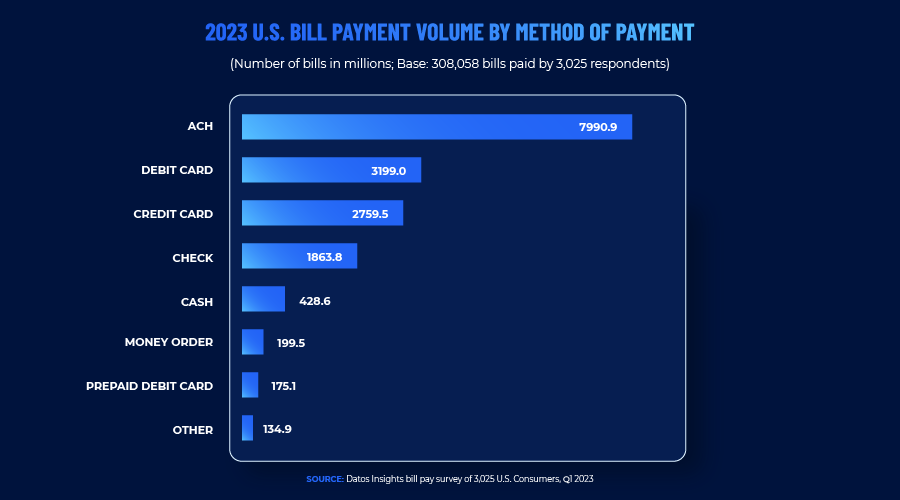Decluttering Today’s Card Landscape
The arrival of spring brings about many welcome changes (warm weather, flowers blooming, birds chirping and one likely unwelcome tradition: spring cleaning. While not always fun, spring cleaning provides that unique opportunity to remove the clutter that is likely limiting the enjoyment and functionality of your home or office, and allows that brilliant sunlight to radiate off the freshly scrubbed and polished surfaces you may just be seeing again for the first time in months.
Mostly, however, spring cleaning is about simplifying and removing unwanted and unneeded clutter. This is exactly what we’re doing today. Let’s take a second to clear the decks and get a fresh look at today’s payment landscape.
Spring Cleaning for Billing and Payments
Spring cleaning has many applications as it relates to billing and payments. The expanding payment ecosystem now features more payment methods than ever, including traditional ACH, expanded cash bill pay and popular digital wallets. While each offers unique benefits and complexities, none of these options offers the same mix of dynamic challenges and usage as cards.
For a payment type that has existed for decades, debit cards and credit cards continue to present a unique challenge for the merchants and billers that accept them.
The complexity and dynamic nature of today’s card landscape makes it near impossible for the everyday consumer to keep up. When you consider EMV, CVV, CNP, NFC tap, swipe, store, Durbin Acts, interchange fees, convenience fees, surcharges, chargebacks – it’s enough to make anyone wish we could go back to the world of cash and checks.
Well, almost anyone. Recent statistics from our latest How Americans Pay Their Bills industry report shows that customers love paying bills with debit and credit cards.

Why Debit and Credit Cards Are Popular Payment Types
According to Miles Tullo, managing director for banking and payments at J.D. Power, the top reasons consumers give for paying with a debit card are that it gives them a way to track and manage their spending, speeds the transaction and offers ease of use.
For credit cards, the answer can be found in rewards. These can be anything from cash back incentives to airline miles. Many people use credit cards for all of their regular purchases and payments, and pay each statement as it comes due so as to not incur interest charges. Credit cards are unique in that they are one of the few forms of payment that can earn the user some type of reward, financial or otherwise.
Recent Rules, Regulations and Fees to Know
Ongoing legislative efforts continue to address everything from card rails to fees. While too numerous to name in this article, a few recent pieces of legislation and standard fees are worth mentioning.
Credit Card Competition Act
The Credit Card Competition Act, introduced in 2022 and re-introduced in 2023, seeks to enhance credit card competition and choice to reduce excessive credit card “swipe fees.” This would be accomplished by requiring the largest credit-card issuing financial institutions to enable at least two credit card networks be used on their cards, instead of just one. Supporters argue that this would reduce fees by opening markets to greater competition.
Digital Commerce Service Fees
Card issuers networks may enact fees for various reasons including the cost of adhering to regulations and providing services to ensure the greatest security for cardholders. In this vein, some card issuers have enabled a Digital Commerce Services fee of .0075% of all card-not-present (CNP) transactions. CNP is a transaction that takes place online or through the phone (IVR) (i.e., some of the most popular forms of payment for today’s bill payers).
Interchange Fees
If you’ve ever visited a merchant that had a minimum transaction amount for credit cards, interchange fees are the reason. Interchange fees are set by the payment networks that cards run on and are used to fund everything from the operations of the network to the rewards programs offered. This fee is charged to the merchant, with a cut of each fee going to the card issuer as “interchange.”
Convenience Fees
Convenience fees differ from interchange fees in that they are charged by businesses to cover the cost of processing the payment. You have likely paid this fee when paying a bill online or making a purchase through a merchant’s website. Enacting convenience fees is solely the choice of the biller. While many do choose to pass this cost to consumers, some will absorb this cost in what’s called an absorbed model.
Decluttering Debit and Credit Card Complexity
With debit and credit card payments viewed as table stakes for most organizations, how can you declutter such a widely regulated, dynamic ecosystem and get the most from these payment methods? Here are a few tips.
1. Find Your Plastic Partner
Much like how consumers rent storage units to hold their excess clutter, it’s important for billing organizations to rely on outside vendors that offer the dedicated expertise to stay ahead of debit and credit card changes. Paymentus offers decades of experience helping thousands of billers offload the burden of keeping up with sweeping regulations or changing fees. Select a partner with a dedicated team that can keep you informed and compliant.
2. Answer the Question: To Fee or Not to Fee
Depending on your organization’s business model, you may opt for either an absorbed model (where you absorb the cost of processing card transactions charged by your provider) or a convenience fee model (where you pass the cost onto the consumer). Card-paying consumers are likely used to paying these fees, as many online retailers charge them. However, should you choose to implement convenience fees, it’s important to communicate this properly and understand any regulatory obligations. Paymentus offers change management resources to help ensure customer satisfaction during this potentially sensitive transition.
3. Consult Industry Resources
Paymentus recommends that all organizations maintain a high-level view of the debit and credit card industry but of course we are here to help and remove much of the burden of managing this daunting task. There are numerous sites and newsletters that are worth subscribing to (Payments Dive, Nerdwallet.com, etc.). In addition, Visa, Mastercard, American Express and Discover all offer a host of resources related to their offerings.
Looking to declutter your billing and payment offering? Contact us today to learn more about how Paymentus can help you maximize and modernize your payment solutions today.



